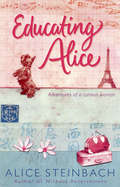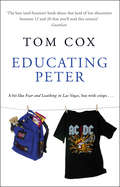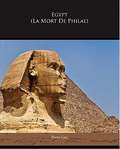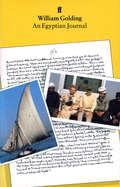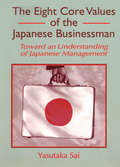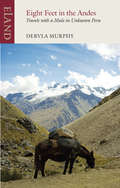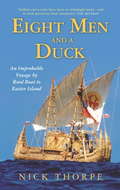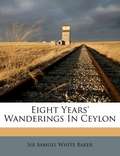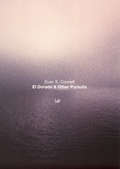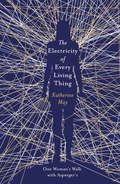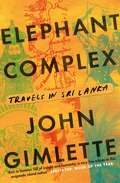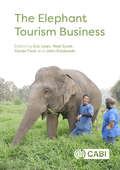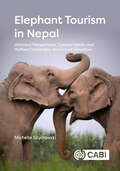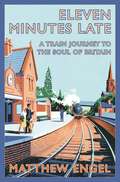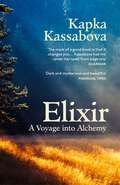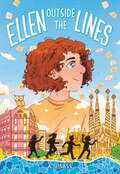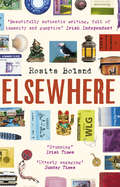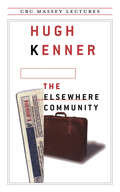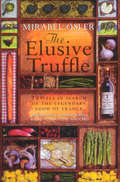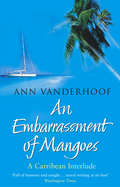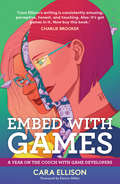- Table View
- List View
Educating Alice: Adventures Of A Curious Woman
by Alice SteinbachA few years ago, Alice Steinbach, a Pulitzer prize winning journalist decided to take a break from her life. She took a leave from her job, friends and family to go on a European journey of self-discovery, and her first book, WITHOUT RESERVATIONS, was the exquisite result of that trip.But once Steinbach had opened the door to a new way of living, she found herself unwilling to return to her old routine. She left her job and went travelling again, only this time her objective was not so much one of self-discovery as it was a reaching out. She wanted to learn, by taking lessons and courses, but also by connecting to and learning from the people she would encounter along the way.Choosing exactly where to go and what to study turned out to be harder than she'd anticipated, but Steinbach found herself repeatedly drawn to the interests and fantasies of her youth. And so her lifelong fascination with writing, animals, gardening, and food led her to study dog training in Scotland, writing in Prague, gardening in Provence, calligraphy and flower arranging in Kyoto, music in Cuba, cooking in Paris and Jane Austen in Exeter.Her weeks and months spent with fellow students of all ages are, as she'd hoped, every bit as educational as her courses. And studying side by side with people preparing for careers in these various fields gives Steinbach a second chance at some roads not taken - a chance to reconnect with her past, when so many options were still open to her. In pursuing interests she's never had time to fully explore, she finds that her sense of curiosity is as strong as it ever was, and, as she discovers during the course of this wonderful trip, we are never too old to learn.
Educating Peter: A Bit Like Fear And Loathing In Las Vegas, But With Crisps...
by Tom CoxPeter's mum and dad are worried. Over the last twelve months they've noticed ferocious changes taking place in their son. It's not just the mumbling and the cloud of melancholy that seems to hover permanently over his ever-more-militant mop of curly hair. It's not even the oversized trousers or the numerous metal chains that hang off them. The problem is that Peter, who is fourteen, wants to be a musician - a rock star preferably, but anything else that involves a guitar, gets him bags of money and free CDs, and gives him access to unlimited scantily clad groupies will suffice (as long as it's not classical). Uncoincidentally, ever since the advent of this new ambition, Peter's grades at school have plummeted from very good to somewhere below mediocre. What is to be done? In the spirit of intellectual enquiry, Peter and music-critic, Tom Cox, set off in a Ford Focus on a journey to the dark heart of Britain's musical heritage, to get the inside track on whether being a musician really is a sensible career choice for a teenager. They hunt the streets of Cambridge for former Pink Floyd frontman Syd Barrett and have numerous encounters with folkies in tights. They explore the wilder shores of prog rock and get up close and personal in a lift with Brian Wilson. Tom gives a masterclass in second-hand-record-shop etiquette and finds that Peter is something of a child prodigy. Most of all, they drive around, talk about stuff and Peter eats crisps.Part coming-of-age story and part urban travelogue, this brilliantly funny book is a must for anyone who has ever been baffled by a teenage boy.
Egypt (La Mort de Philae)
by Pierre LotiClassic work from the French sailor who travelled extensively and achieved popularity with his impressionistic romances of adventure in exotic lands. The title refers to an ancient island temple in Upper Egypt.
Egyptian Gallery: Egyptian Boat Model (tactile)
by RnibEgyptian Gallery: Egyptian Boat Model. Sedment, Egypt; 2160-2025 BC; wood; 60 cm long by 11 cm wide and a total of 58 cm high including the height of the mast which is 29 cm. The earliest boats were made from reeds and later from wood. Water travel was both a part of daily life and an important religious symbol.Large ships transported heavy building stone hundreds of miles along the Nile. Cargo boats carried grain.Broad barges carried cattle from one side of the Nile to the other. Pharaohs travelled by royal barge. The sun-god Ra travelled across the sky by boat. The Egyptians sometimes left the Nile (via the river's mouth) to sail on the Mediterranean or the Red sea but mostly stayed close to the shore. This boat model is over 4000 years old. It was placed in a tomb to speed along the owner's journey to the afterlife and for them to enjoy sailing there. The boat has a flat bottom with the pointed bow (front) and stern (back) curved upwards so that they would have been out of the water. The stern is raised slightly more than the bow. About a third of the way along the boat from the bow is a mast with a furled sail wrapped around it. Ropes are attached to the top of the mast and tied at the bow and stern. The sail also has ropes attached for raising and lowering it. At the stern is a large brown steering oar and immediately in front of this oar is a white canopy on four legs. The flat white deck of the boat has 8 male figures, painted with dark brown skin, white kilts, black wigs and white and black eyes, are either standing or sitting on it, mostly in pairs, and all facing the bow. At the bow is a standing man who is holding a large white stone with black markings attached to a rope that would have been used to test the depth of the water. Behind him, just in front of the mast, are two men standing with oars laid across the deck immediately in front of them. In the centre of the boat are two men sitting holding oars as if rowing. Behind these are two men standing with their arms outstretched as if rowing. Behind these is the canopy and at the stern is a single seated man who has an oar in his hands. The oars are brown with a white paddle that is roughly diamond shaped. The tactile image shows five of the eight figures and is roughly half the size of the actual object. The boat is shown with solid texture with a rough texture for the flat deck. The figures are shown in outline with solid texture for their black wigs, a texture for their kilts, no texture for their skin and a spot for their eyes. The oars, masts and legs of canopy are shown as solid texture. The sail, stone and canopy are shown with a different texture. Fine lines show the ropes from the mast and sail.
An Egyptian Journal
by William GoldingA first-hand journal about the Goldings' travels through Egypt, soon after winning the Nobel Prize, living on a motor cruiser on the Nile. Nothing went quite as planned, but William Golding's vivid and honest account of what actually happened, and of what he saw and felt about ancient Egypt and the exasperations of the living present, will delight his innumerable admirers and everyone who visits Egypt.'One of the funniest anti-travel books I have ever read.' Daily Telegraph'No previous book brings you so close to Golding the man. It bulges with abstruse knowledge . . . and is often screamingly funny . . . Hugely enjoyable.' The Times
Egypt's African Empire: Samuel Baker, Charles Gordon & the Creation of Equatoria
by Dr Alice Moore-HarellThis book is a detailed and original study of the creation of the province of Equatoria, located in present-day Southern Sudan. No detailed account has previously been published on the effort to conquer and create a new Egyptian province in the 1870s in the interior of Africa, despite its importance to the history of the on-going northsouth conflict in the Sudan. The annexation of Equatoria emerged from the Khedive (viceroy) Ismail's aspiration for an African empire that would control the source of the White Nile at Lake Victoria. At the time he was under pressure from the British government to suppress the lucrative slave trade in the Turco-Egyptian Sudan, and to this end the new province was to be under direct control of Cairo and not the authorities in Khartoum. The two conquering expeditions of Equatoria were led by Britons, Samuel Baker and Charles Gordon (later Governor-General of the Sudan). With them were other Europeans, Americans, Sudanese and Egyptians. Baker, Gordon and some of the others left detailed accounts of their experience in the region. All of which contribute to our knowledge not only of the difficulties involved in the annexation of a region thousands of kilometres from Cairo, but also geographical data and a record of the complex human relations that developed between the men involved in the expeditions, and the creation of the new province. Official documents from the Egyptian state archive, Dar al-Wathaiq, provide detailed accounts of the politics of the annexation of Equatoria, and these accounts are discussed in their historical context.
The Eight Core Values of the Japanese Businessman: Toward an Understanding of Japanese Management
by Erdener Kaynak Yasutaka SaiThe values and behaviors of the Japanese businessman--and of the Japanese in general--are quite diverse and keep changing, making it difficult for anyone (including the Japanese themselves) to truly understand why they act the way they do. The Eight Core Values of the Japanese Businessman saves readers time and effort when pursuing business opportunities in Japan because it identifies the core values of the Japanese businessman, ranging from the obvious and public, “Diligence,” to the more private, “Silence as Eloquence” and “Perception of Time.” After identifying these eight core values, Yasutaka Sai explores the history and modern interpretation of each. Based on over 300 Japanese language sources--otherwise unavailable to those who do not read Japanese--The Eight Core Values of the Japanese Businessman reveals the diversity and dynamism of Japanese values and behaviors. This information empowers businesspeople and international business educators to develop solid business relationships with the Japanese. With many years of experience, the author focuses on specific values that are most common among Japanese in the business world. These are not exclusive, but the most prevalent or widely shared values that Western businesspeople are likely to encounter:Japanese diligence, work ethic, and “Gambarism” or persistencegroup orientation: sense of belonging and participation, spirit of harmony, interpersonal relationsaesthetics and perfectionismcuriosity and emphasis on innovationrespect for form and “Hana Yori Dango” or practicalitya mind for competition and outlook on rewardsthe value of silence as eloquenceperception of timeAs there is no single uniformly accepted source for the values of today's Japanese citizen or business person, Sai's exploration opens a vital window into understanding many Japanese values and behaviors. The Eight Core Values of the Japanese Businessman is vital reading for those with international business concerns--business and management educators, businesspeople interested in how Japanese managers manage and employees work, and practicing managers interested in cross-cultural management issues. It allows readers to develop good relationships with the Japanese based on a realistic understanding of how they think and act, both individually and as members of business organizations.
The Eight Core Values of the Japanese Businessman: Toward an Understanding of Japanese Management
by Erdener Kaynak Yasutaka SaiThe values and behaviors of the Japanese businessman--and of the Japanese in general--are quite diverse and keep changing, making it difficult for anyone (including the Japanese themselves) to truly understand why they act the way they do. The Eight Core Values of the Japanese Businessman saves readers time and effort when pursuing business opportunities in Japan because it identifies the core values of the Japanese businessman, ranging from the obvious and public, “Diligence,” to the more private, “Silence as Eloquence” and “Perception of Time.” After identifying these eight core values, Yasutaka Sai explores the history and modern interpretation of each. Based on over 300 Japanese language sources--otherwise unavailable to those who do not read Japanese--The Eight Core Values of the Japanese Businessman reveals the diversity and dynamism of Japanese values and behaviors. This information empowers businesspeople and international business educators to develop solid business relationships with the Japanese. With many years of experience, the author focuses on specific values that are most common among Japanese in the business world. These are not exclusive, but the most prevalent or widely shared values that Western businesspeople are likely to encounter:Japanese diligence, work ethic, and “Gambarism” or persistencegroup orientation: sense of belonging and participation, spirit of harmony, interpersonal relationsaesthetics and perfectionismcuriosity and emphasis on innovationrespect for form and “Hana Yori Dango” or practicalitya mind for competition and outlook on rewardsthe value of silence as eloquenceperception of timeAs there is no single uniformly accepted source for the values of today's Japanese citizen or business person, Sai's exploration opens a vital window into understanding many Japanese values and behaviors. The Eight Core Values of the Japanese Businessman is vital reading for those with international business concerns--business and management educators, businesspeople interested in how Japanese managers manage and employees work, and practicing managers interested in cross-cultural management issues. It allows readers to develop good relationships with the Japanese based on a realistic understanding of how they think and act, both individually and as members of business organizations.
Eight Feet in the Andes: Travels with a Mule in Unknown Peru (Century Travellers Ser.)
by Dervla MurphyTraveller Dervla Murphy and her nine-year-old daughter Rachel, accompanied by an endearing mule named Juana, clambered the length of Peru with only the most basic supplies to sustain them, spending most of their time above 10,000 feet. Their gruelling journey was marked by discomfort and danger, though mother and daughter remained resilient throughout, sustained by their great affection for the beauty of the Andes and impoverished people who live there. Eight Feet in the Andes takes the reader on a journey from Cajamarca, near the border with Ecuador, to Cuzco, the ancient Inca capital, over 1300 miles to the south. Confronting horrors and joys along the mountain paths, the Murphy women prove that they are as indomitable as ever.
Eight Men And A Duck: An Improbable Voyage by Reed Boat to Easter Island
by Nick ThorpeNick Thorpe was innocently travelling around South America with his wife, Ali, when he came across an American adventurer planning to sail from Chile to Easter Island on a Bolivian boat made of reeds. Inspired by the great Thor Heyerdahl, Phil Buck had recruited seven men to join him on this experiment to discover whether it might have been possible that Polynesia was first settled from South America rather than Asia. But when one of them dropped out a place in the crew became available for Nick.What followed was a somewhat bizarre expedition undertaken by a rather makeshift vessel, a couple of ducks (one of which could have only guessed at its fate) and a group of men, who, when all was said and done, weren't quite sure how to sail a boat...Brilliantly told, EIGHT MEN AND A DUCK is a feel-good, hilarious tale of storms, amateur seamen and the occasional shark.
Eight Years' Wanderings in Ceylon
by Sir Samuel White Baker"It was in the year 1845 that the spirit of wandering allured me toward Ceylon: little did I imagine at that time that I should eventually become a settler." Baker eventually founded an agricultural settlement in Ceylon (now Sri Lanka) and found a "love for this beautiful island which can only be equaled by my affection for Old England."
Einstein’s Fridge: The Science Of Fire, Ice And The Universe
by Paul SenA compulsively readable account of the extraordinary people, battling internal demons and external adversaries, who discovered the laws of thermodynamics and the science of heat, and brought about a scientific revolution.
El Dorado And Other Pursuits
by Evan S ConnellEvan S. Connell explores the quixotic obsession with the new, the hidden, the unattainable that burns in an individual's soul. Each essay is an extraordinary account of passionate pursuit by legendary explorers, visionaries, and seekers compelled by a singular desire. Here we find Marco Polo, El Dorado, Paracelsus, Columbus, the thousands of children in the Innocents' Crusade, Magellan, Mary Kingsley (a Victorian naturalist, ethnologist, sailor, scholar, and guest of cannibals, and Ibn Batuta (an indefatigable explorer of the fourteenth century whose travels in the Arab world and beyond made 'the journey of Marco Polo look like a stroll around the block'). 'There's no end to the list, of course,' Connell adds, 'because gradually it descends from such legendary individuals to ourselves when, as children, obsessed by that same urge, we got permission to sleep in the backyard.'
The Electricity of Every Living Thing: A Woman’s Walk in the Wild to Find Her Way Home
by Katherine MayPerfect for fans of The Salt Path and The Outrun, this book is a life-affirming exploration of wild landscapes, what it means to be different and, above all, how we can all learn to make peace within our own unquiet minds.'A windswept tale, beautifully told' Raynor Winn - The Salt Path 'A manifesto for the value of difficult people. I loved it' Amy Liptrot - The OutrunIn August 2015, Katherine May set out to walk the 630-mile South West Coast Path. She wanted to understand why she had stopped coping with everyday life; why motherhood had been so overwhelming and isolating, and why the world felt full of inundation and expectations she can't meet. Setting her feet down on the rugged and difficult path by the sea, the answer begins to unfold. It's a chance encounter with a voice on the radio that sparks a realisation that she has Asperger's Syndrome. The Electricity of Every Living Thing tells the story of the year in which Katherine comes to terms with her diagnosis. It leads to a re-evaluation of her life so far - a kinder one, which finally allows her to be different rather than simply awkward, arrogant or unfeeling. The physical and psychological journeys become inextricably entwined, and as Katherine finds her way across the untameable coast, she also finds the way to herself.What readers are saying about The Electricity of Every Living Thing:'This book showed a realistic view of how autism feels to some people, and it's explained so well''The astonishing sensitivity and awareness in her writing, both about the beautiful landscapes and nature around on her walks, and in relation to her family, friends and self put paid to many outdated myths about what it is like to be autistic''Compelling and transformative'
Elephant Complex: Travels in Sri Lanka (Vintage Departures Ser.)
by John GimletteA gripping account of an under-reported island' Spectator, Book of the Year '[A] brilliant new book about an island that has a geography from heaven and a history from hell' Daily Telegraph'A brilliant work of travel, history and psychological insight . . . astute and sympathetic . . . very funny' Wall Street Journal Everyone has wanted a piece of paradiseJohn Gimlette - winner of the Dolman Prize and the Shiva Naipaul Prize for Travel Writing - is the kind of traveller you'd want by your side. Whether hacking a centuries-old path through the jungle, interrogating the surviving members of the Tamil Tigers or observing the stranger social mores of Colombo's city life, he brings his own unique insight to the page: a treasure-chest of research and a gift for wry amusement. Through him, Sri Lanka - all at once dazzling, strange, conflicted and beautiful - comes to life as never before.
The Elephant Tourism Business
by Ann Suwaree Ashton Liv Baker Sumanth Bindumadhav Sarah Blaine Eric Brymer Naphawan Chantradoan Saranphat Chotmanakul Qingming Cui Susanna Curtin Charlotte Day Nilakshi Galahitiyawe Vivek Gurusamy Professor Xavier Font Nicole Hausler Jeffrey Dale Hobbs Claire Jenkinson Professor John Koldowski Naut Kusters Eric Laws Shilpa Mahbubani Andrew McLean Mucha Mkono Somyot Ongkhluap Anja Pabel Piengpen Na Pattalung Clive Phillips Kannapa Pongponrat Bongkosh Rittichainuwat John Edward Roberts Andrea Saayman Melville Saayman Jan Schmidt-Burbach Professor Noel Scott Alokparna Sengupta Vinathe Sharma-Brymer Ramona Strödecke Daminda Sumanapala Daniel Turner Marjorie Van Strein Rebecca Winkler Isabelle Wolf Honggang XuElephant tourism is a growing activity in many countries across Asia and Africa and is popular with tourists from all parts of the world. Elephant tourism has grown rapidly, providing the only viable way for elephants and their owners to survive since the banning of logging. Old logging camps have been developed into sanctuaries for some elephants, but many other camps were established as entertainment centres, resulting in serious welfare issues for the elephants and their mahouts. The profits from elephant tourism in Asia have encouraged African operators to follow a similar business model. This book draws attention to the need for a comprehensive and rigorous focus on local solutions to improve the welfare of captive elephants, their mahouts and local residents, and to enhance tourists' experiences of elephant tourism. It achieves this by: - Critically reviewing recent research into elephant tourism. - Providing contemporary analytical case studies of elephant tourism policy and practice. The Elephant Tourism Business will contribute to a better understanding of how elephant tourism is organised, regulated and promoted, both in elephant areas and tourist origin countries. It identifies priorities for future research into elephant tourism and provides a unique, authoritative resource for researchers, elephant managers and administrators, and tourism managers. The book will be of interest to academics and practitioners with backgrounds in conservation, the environment, tourism and veterinary sciences, and will appeal to tourists keen to experience elephants in person.
Elephant Tourism in Nepal: Historical Perspectives, Current Health and Welfare Challenges, and Future Directions
by Dr Michelle SzydlowskiA study of elephant tourism in Nepal from its origins in the 1960s to the present day, this book examines the challenges faced by captive elephants. Used as human conveyance, on anti-poaching patrol teams, as rescue vehicles, and in forestry service, elephants have worked with and for humans for hundreds of years. However, the use of elephants in tourism is a fairly new development within Nepal. Because the health and welfare of tourism elephants is vital to the conservation of wild individuals, this book offers an assessment of captive elephant needs and an examination of their existing welfare statuses. Numerous NGOS and INGOs are now active in elephant lives, and numerous advocacy organizations have arisen with the goal of changing tourism practices and improving captive elephant welfare. This book seeks to examine the motivations of these NGOs and INGOs, and to consider their ethical approaches to elephant health and welfare. Are the motivations of these organizations similar enough to work together towards a common goal, or are their ethical norms so different that they get in one another's way? Using an ordinary language and ethics framework, this text aims to identify the norms of cultures and organisations and reframe them in ways which may allow for more successful interactions.
Eleven Minutes Late: A Train Journey to the Soul of Britain
by Matthew EngelBritain gave railways to the world, yet its own network is the dearest (definitely) and the worst (probably) in Western Europe. Trains are deeply embedded in the national psyche and folklore - yet it is considered uncool to care about them. For Matthew Engel the railway system is the ultimate expression of Britishness. It represents all the nation's ingenuity, incompetence, nostalgia, corruption, humour, capacity for suffering and even sexual repression. To uncover its mysteries, Engel has travelled the system from Penzance to Thurso, exploring its history and talking to people from politicians to platform staff. Along the way Engel ('half-John Betjeman, half-Victor Meldrew') finds the most charmingly bizarre train in Britain, the most beautiful branch line, the rudest railwayman, and - after a quest lasting decades - an Individual Pot of Strawberry Jam. Eleven Minutes Late is both a polemic and a paean, and it is also very funny.
Elixir: In the Valley at the End of Time
by Kapka KassabovaSet in the valley of the Mesta, one of the oldest inhabited river valleys in Europe and a nexus for wild plant gatherers, Elixir is an unforgettable exploration of the deep connections between people, plants and place.‘Kassabova had me under her spell from page one’GUARDIANOver several seasons, Kapka Kassabova spends time with the men and women of this magical region. She witnesses their rare knowledge, not only of mountain plants and the ancient practice of herbalism, but also of how to transform collective suffering into healing. Elixir is, at its heart, an urgent, hopeful call to rethink how we live – in relation to one another, and to the world around us.‘Dark and mysterious and beautiful’ FINANCIAL TIMES‘Uplifting and beautifully written’ MARK COCKER, SPECTATOR‘Extraordinary’ COUNTRY LIFE
Ellen Outside the Lines
by A. J. SassWinner of a Sydney Taylor Book Award Honor! A heartfelt novel about a neurodivergent thirteen-year-old navigating changing friendships, a school trip, and expanding horizons for fans of Rain Reign and Ivy Aberdeen's Letter to the World. Thirteen-year-old Ellen Katz feels most comfortable when her life is well planned out and people fit neatly into her predefined categories. She attends temple with Abba and Mom every Friday and Saturday. Ellen only gets crushes on girls, never boys, and she knows she can always rely on her best-and-only friend, Laurel, to help navigate social situations at their private Georgia middle school. Laurel has always made Ellen feel like being autistic is no big deal. But lately, Laurel has started making more friends, and cancelling more weekend plans with Ellen than she keeps. A school trip to Barcelona seems like the perfect place for Ellen to get their friendship back on track. Except it doesn't. Toss in a new nonbinary classmate whose identity has Ellen questioning her very binary way of seeing the world, homesickness, a scavenger hunt-style team project that takes the students through Barcelona to learn about Spanish culture and this trip is anything but what Ellen planned. Making new friends and letting go of old ones is never easy, but Ellen might just find a comfortable new place for herself if she can learn to embrace the fact that life doesn't always stick to a planned itinerary.
Elsewhere: One Woman, One Rucksack, One Lifetime of Travel
by Rosita Boland____________________From her first life-changing solo trip to Australia as a young graduate, Rosita Boland was enthralled by travel. In the last thirty years she has visited some of the most remote parts of the globe carrying little more than a battered rucksack and a diary.Documenting nine journeys from nine different moments in her life, Elsewhere reveals how exploring the world – and those we meet along the way – can dramatically shape the course of a person’s life. From death-defying bus journeys through Pakistan to witnessing the majestic icescapes of Antarctica to putting herself back together in Bali, Rosita experiences moments of profound joy and endures deep personal loss.In a series of jaw-dropping, illuminating and sometimes heart-breaking essays, Elsewhere is a book that celebrates the life well-travelled in all its messy and wondrous glory.'Beautifully authentic writing, full of humanity and gumption' Irish Independent ____________________
The Elsewhere Community (The CBC Massey Lectures)
by Hugh KennerAcclaimed literary critic Hugh Kenner examines Western culture's insatiable need for stimulation encountered elsewhere - from the eighteenth century's Grand Tour, to the self-imposed exile of modernist writers, to the disembodied global journeys the Internet avails us today. Kenner brings to this fascinating study knowledge of a wide array of disciplines. Hugh Kenner has written on topics ranging from geodesic domes to Bugs Bunny, but is perhaps best known for The Pound Era, his definitive study of Ezra Pound's life and work.
The Elusive Truffle: Travels In Search Of The Legendary Food Of France
by Mirabel OslerIn years gone by, the traveller in France could rely on coming across a restaurant where the tables were ready-laid with heavy cotton napkins, a carafe of wine and a basket of freshly baked bread, and where the ensuing meal would encompass recipes of remarkable local dishes handed down from generation to generation. But no longer.In an inspiring quest for this rapidly disappearing traditional cuisine and culture, Mirabel Osler travels the length and breadth of France, focusing on individual chefs and restaurants, exploring producers and suppliers such the travelling butchers and bakers, and the local markets where much of the produce is bought. It is an enticing and evocative picture of a way of life which is fast being eroded by the modern world, but also an affirmation that, for some, the old traditions will always survive.
An Embarrassment Of Mangoes: A Caribbean Interlude
by Ann VanderhoofWho hasn't fantasized about leaving their job, saying goodbye to the rat race and escaping to some exotic destination in search of sun, sand, and a different way of life? Ann Vanderhoof and her husband did just that.In the mid 1990s, the author and her husband were driven, forty-something professionals who were desperate for a break from their harried, deadline-dominated lives. So they left their jobs, rented out their house, moved onto a 42-foot yacht called Receta ('recipe' in Spanish) and set sail from their home in Canada for the Caribbean. AN EMBARRASSMENT OF MANGOES is Ann Vanderhoof's intimate account of this two-year midlife interlude during which she and her husband travelled more than 7,000 nautical miles, dropped anchor in 16 countries (and 47 individual islands), and adapted to a new life on 'island time'.Exchanging suits for bare feet, they leave the stresses of their old life behind and become caught up in a world that is simultaneously simpler and more exuberant. They sip rum with their neighbours and dance through the streets during Carnival, explore secluded beaches, learn to pull their dinner from the sea and create delectable dishes in their tiny galley kitchen. Interspersed with irresistible recipes, from cracked conch in the Bahamas, curried lobster in Grenada, spicy island gingerbread to West Indian rum punch, AN EMBARRASSMENT OF MANGOES is the enticing story of discovering not just vibrant new cultures and cuisines, but what really matters.
Embed With Games: A Year on the Couch with Game Developers
by Cara EllisonIn 2014 games critic Cara Ellison rather flippantly pledged to the internet she’d leave home, become itinerant, and travel around the world to live with and write about some of the most interesting game developers and their cultural outlook. As your ‘cyberpunk hair-dyed Attenborough’, originally Cara put up the Embed With Games series monthly on a free blog as she travelled from couch to couch, writing about the people she met and about the way our game creators express the culture around them. The internet generously helped fund her travel costs through a subscription service, egging her on in the only way it could. This is the collected work, called Embed With Games with an exclusive introduction from Kieron Gillen, a cover from Irene Koh, and a conclusion exclusive to the eBook.
